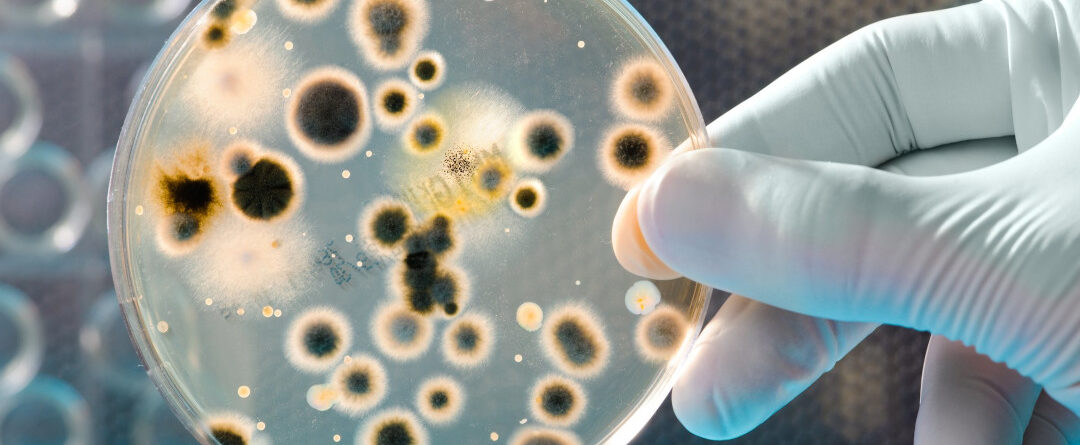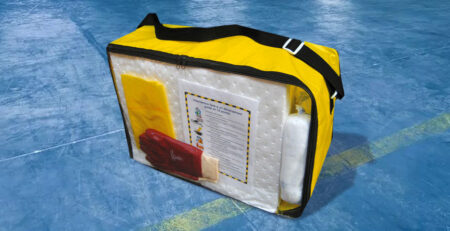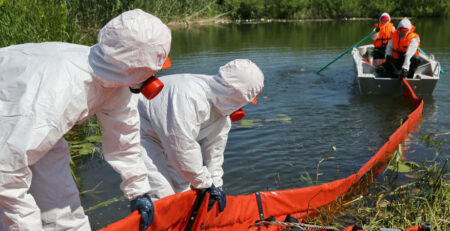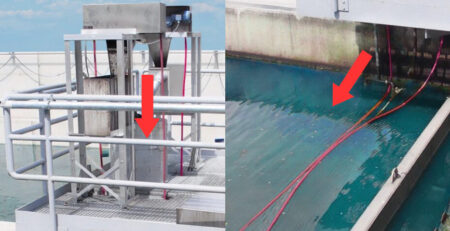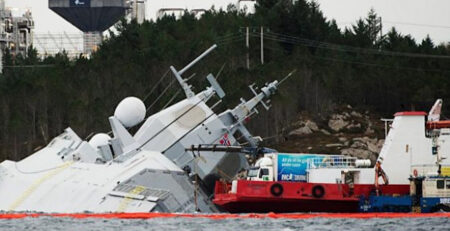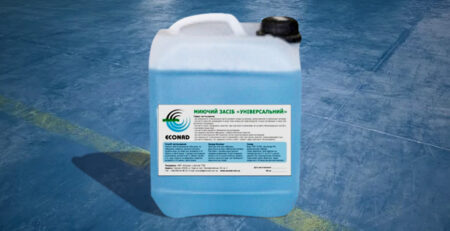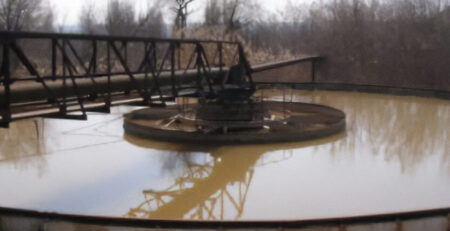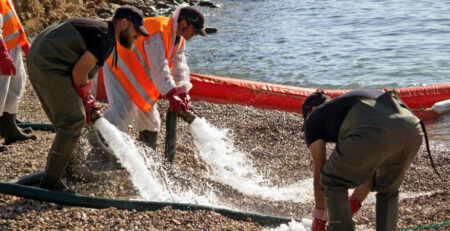Medical aspects and sanitary and hygienic assessment of bacterial preparations used to combat oil pollution of water bodies
Soloviev V.I.
Pushkina V.A.
Kozhanova G.A., Gudzenko T.V.
The most common and dangerous pollution of the aquatic environment is oil and oil products due to their properties and scale of use. In recent years, accidental oil spills have become more frequent in Ukraine, due to the deterioration of pipelines, as well as unauthorized tie-ins in them with the aim of stealing oil and oil products. In this regard, the geography of oil-contaminated reservoirs has expanded: in addition to the water areas of ports, water bodies adjacent to large industrial centers traditionally polluted with oil and oil products, hundreds of small reservoirs, small rivers, into which oil and oil products fall as a result of oil accidents, have been added. – and product pipelines.
For the mechanical removal of oil and oil products from the water surface, oil and garbage collectors are used in large ports, and skimmers or vacuum vehicles are used in small reservoirs. These mechanisms provide high oil recovery performance, but do not remove residual films and are powerless in collecting oil in berthing areas, floodplains and swampy areas.
Various sorbents of organic, mineral origin or based on polymers are used to combat oil films and oil spills in hard-to-reach places for mechanisms. Despite obtaining the primary environmental effect: breaking continuous film pollution, sorption of dissolved and emulsified oils, they also have a significant drawback – they require collection and disposal, which are not always feasible in practice.
The most environmentally friendly way to combat oil pollution of the aquatic environment is the stimulation of natural self-cleaning processes in water bodies and the introduction of oil-oxidizing microorganisms into them. However, methods for stimulating natural self-cleaning processes for water bodies have not gone beyond the scope of scientific research and experimental studies.
At the same time, in recent decades, several dozen preparations have been proposed for the introduction of oil-oxidizing microflora into water bodies. The most famous drugs in Russia are Putidoil, Oleovorin, Naftoks, Uni-rem, Roder, Centrin, Pseudomin, Destroyl, Mikromycet, Leader, Valentis, “Devoroil”, in Belarus – “Rodobel”, “Rodobel-T”, in Ukraine – “Econadin”, “Desna”, “Consortium of Microorganisms” and “Simbinal”. The composition of these preparations includes monocultures or associations of more than 20 types of various oil-oxidizing microorganisms: bacteria, fungi, yeast.
Despite the fact that the drugs used in Ukraine have various kinds of permits from institutions of the Ministry of Health of Ukraine and Russia, some are recommended by the Ministry of Ecology and Natural Resources of Ukraine, there are no unified sanitary and hygienic criteria for evaluating these drugs and their regulation in Ukraine. It should also be noted that all drugs used in Ukraine, except for “Destroyl”, have no restrictions on the use depending on the categories of water use of various water bodies.
L. A. Vinogradova (1) notes that the anthropogenic load on water bodies due to the violation of the ecological microsystem can be accompanied by the intensive development of pathogenic and potentially pathogenic microorganisms. The role of water as a transmission factor in the occurrence of sporadic cases and epidemic outbreaks of various diseases is known, which also determines the need for sanitary and microbiological control (2, 3). In this regard, the use of significant amounts of biomass of various microorganisms in water bodies for environmental purposes requires consideration from a medical and environmental point of view.
In Ukraine, industrial volumes are currently used “Putidoil” – based on Pseudomonas putida, “Destroyle” – based on Acinetobacter sp., “Devoroil” – based on two types of bacteria of the genus Rhodococcus, P. aeruginosa and yeast-like fungi of the genus Candida, “ Oleovorin” (the composition is not known to us), “Econadin” based on P. fluorescens and “Desna” based on Bacillus megaterium. In 2001, the Ministry of Ecology and Natural Resources of Ukraine recommended the drug “Simbinal” for these purposes, which includes microorganisms: Aeromonas sp., Arthrobacter globiformis, Bacillus sp., B. subtilis, Citrobacter sp., Flavobacterium tirrenicum, Nocardia sp., Pseudomonas aeruginosa, P. fluorescens, P. putida, P. stutzeri, Aspergillus candidus, A. glaucus, A. terreus, Penicilium frequentans.
Most of the listed types of microorganisms belong to pathogens of various priority levels (4) and can be classified as opportunistic pathogens (5, 6, 7).
It should be noted that in modern conditions in developed countries the number of typical infectious diseases is decreasing, along with this, there is an increase in the role of opportunistic microorganisms in human pathology. The disease process depends on the interaction of three factors: the pathogenic properties of microorganisms, their number and human defense mechanisms (5). In this regard, the growth of immunodeficiency states of the body, on the one hand, and the possibility of increasing the concentrations of certain types of microorganisms (due to anthropogenic transformation of the external environment), on the other, certainly create a danger of developing diseases. Indicators of etiologically significant amounts of conditionally pathogenic microorganisms in the water of natural and artificial ecosystems range from 105 to 106 cells/l.
When using biodestructors, the initial concentration of microorganisms in working solutions reaches 105-107 cells/ml. Further microbiological control of water systems after the use of biodestructors is not carried out. At the same time, a number of authors provide data on the intensive development of certain groups of microorganisms: mycobacteria, corynebacteria, pseudomonads, yeast-like fungi of the genus Candida, when aquatic biocenoses are contaminated with oil hydrocarbons (8, 9).
A significant number of works are devoted to the medical significance of microorganisms, which in recent years have begun to be used as biodestructors. Selective information about some of them, of course, is of interest to physicians and ecologists.
- P. aeruginosa bacteria (included in Devoroil and Simbinal biologics) are regarded as medium priority pathogens in clinical material. Along with other microorganisms, these bacteria are an etiological factor in the development of sinusitis, otitis media, skin diseases (including eczema), and uroinfections. In addition, they can cause severe septic processes, folliculitis, endocarditis, etc. The possibility of nasopharyngeal carriage of P. aeruginosa has been described. These microorganisms are in one of the first places among the causative agents of nosocomial infections. Thus, the proportion of hospital infections caused by P. aeruginosa in the territory of the former USSR ranges from 14.5 to 75.2% (7). An outbreak of pseudomonas infection in the neurosurgical department of a French hospital is described, where 36 people fell ill. The multiresistant P. aeruginosa 011 strain was isolated from patients and from the clinic’s tap water (10).
It should also be noted that P. aeruginosa bacteria are characterized by high antibiotic resistance, as well as resistance to disinfectants, including chlorine (10, 11, 12). - P. aeruginosa is ecologically closely related to human habitats. Their entry into water and soil is associated with contamination by human waste products (11). Constant human contact with soil and water, in which P. aeruginosa is present, according to V.I. Ilyukhin (13), is not limited to mechanical carriage. The CMEA Standing Commission for Cooperation in Environmental Protection (14) believes that the detection of P. aeruginosa in water (even chlorinated) in bathing pools and other bodies of water can cause intestinal infections in young children and cause diseases of the external and middle ear, sinusitis in bathers , including in persons with normal immunity (athletes – swimmers) (12). The pathogenicity of Pseudomonas aeruginosa for fish and various mammals has been shown (12).
- P. putida bacteria (included in the biological preparations “Putidoil” and “Simbinal”) cause inflammatory processes in obstetrics and gynecology. Sporadic cases of inflammatory processes in other organs, single nosocomial (nosocomial) infections have been described (4, 5).
- Bacillus subtilis (included in the biological product “Simbinal”) – until recently regarded as pathogenic microorganisms. It has now been proven that once they enter sterile cavities and cerebrospinal fluid, they can also cause disease (5).
It is absolutely unacceptable, from our point of view, to include in the composition of preparations microorganisms that are not identified to the species, for example, Bacillus sp., which may mean from B. anthracis to B. macerans. - Yeast-like fungi of the genus Candida (included in the Devoroil biological product) belong to the group of opportunistic pathogens, the clinical significance of which is increasing every year. They can be considered from two positions – as causative agents of candidiasis and as participants in microbial associations in bacterial and viral infections that aggravate their course (4, 5, 6).
- Bacteria of the genus Acinetobacter (included in the Destroyle biological product) are opportunistic pathogens. Infections of the nasopharynx, skin, conjunctiva, lungs, urogenital tract caused by these microorganisms are described. There are reports of isolated cases of sepsis and meningitis. In recent years, the proportion of Acinetobacter in nosocomial infections in combination with P. aeruginosa has increased. A significant number of multidrug-resistant strains of Acinetobacter have been isolated (5, 15).
- Bacteria of the genus Citrobacter (included in the biological product “Simbinal”) – often cause urinary tract infections, gastrointestinal dysfunction in children, less often other diseases (4, 5).
- Bacteria of the genus Nocardia (included in the biological preparation “Simbinal”) are opportunistic microorganisms that can cause local chronic processes in soft tissues, especially in the lower extremities, purulent processes, brain abscesses (4, 5).</li >
- Mold fungi of the genus Aspergillus (included in the biopreparation “Simbinal”) – cause diseases of the group of mold mycoses. They are associated mainly with single diseases of humans, animals and birds. Distinguish aspergillosis of the skin and mucous membranes. The development of skin lesions contribute to a variety of damage to the stratum corneum, maceration, chronic inflammation of the skin. Aspergillus lesions on the skin of the face, neck, torso, lesions of the mucous membranes of the oral cavity, vagina, disorders of the auditory canal and other diseases are described (4, 5, 12, 15, 16).
It is our deep conviction that the above materials dictate the need to raise and resolve the following questions:
- restrictions on the use of bacterial preparations for water treatment, which include opportunistic types of microorganisms, in water bodies of the first and second categories of water use;
- in the future, when creating new drugs, the selection of microorganisms should be carried out on the basis of their absence of pathogenicity;
- The priority criteria for evaluating strains of microorganisms intended for environmental use should be the absence of signs of toxicity, pathogenicity (invasiveness, virulence and toxigenicity), phytopathogenicity, potential genotoxicity. When using several microorganisms, these indicators should be determined not only for individual strains, but also for the association as a whole.
All of the above indicates the need to develop in the near future a regulation on the sanitary and hygienic assessment of degrading microorganisms included in the composition of biological preparations to combat oil pollution.
List of references
- Виноградова Л.А. Индикация биоценоза потенциально патогенных, индикаторных и патогенных бактерий в водных объектах окружающей среды / Методы индикации биоценоза патогенных и потенциально патогенных микроорганизмов в объектах окружающей среды М.: МНИИГ, 1985.- С. 42-53.
2.Санитарные правила и нормы охраны поверхностных вод от загрязнения /СанПиН 4630-88. 1.01.89 г.- 264 с. - Державні санітарні правила і норми «Вода питна. Гігієнічні вимоги до якості води централізованого господарсько-питного водопостачання» / ДержСанПіН 136/1940. 15.04.97 г.- 14 с.
- Основные методы лабораторных исследований в клинической бак-териологии.-Женева: ВОЗ, 1994.-133 с.
- Славчо Нейчев Клиническая микробиология.- София: Медицина и физкультура, 1977.- 317 с.
- Реброва Р.Н. Грибы рода Candida при заболеваниях негрибковой этиологии.- М.: Медицина, 1989.- 125 с.
- Яфаев Р.Х., Зуева Л.П. Эпидемиология внутрибольничной инфекции.- Л.: Медицина, 1989.-166 с.
- Коронелли Т.В. Микробиологическая деградация углеводородов и ее экологические последствия // Биол. науки. – 1982. — №3. — С. 5-13.
- Израэль Ю.А., Цыбань А.В. Антропогенная экология океана.- Л.: Гидрометеоиздат, 1989.- 257 с.
- Bert F, Maubec E, Bruneau B. et al. Multiresistant Pseudomonas aeruginosa outbreak associated with contaminated tap water in a neurosurgery intensive care unit // J Hosp Infect. –1998.- № 39 (1).- P. 53-62.
- Смирнов В.В., Киприанова Е.А. Бактерии рода Pseudomonas. – Киев, Наукова думка, 1990.- 262 с.
- Медицинская микробиология / Под ред. В.И. Покровского.- М.: ГЭО ТАР Медицина, 1999.- 1200 с.
- Ильюхин В.В. Псевдомонадные инфекции в патологии человека // Журн. микробиол., эпидемиол. и иммунол. – 1985. — № 2. – С.110-112.
- Унифицированные санитарно-микробиологические методы иссле-дования воды в странах СЭВ.- М., 1988.- 238 с.
- McDonald LC, Walker M, Carson L et al. Outbreak of Acinetobacter sp. Bloodstream infections in a nursery associated with contaminated aerosols and air conditioners // Pediatr Infect Dis.- 1998.- № 17(8).- P. 716-22.
- Кашкин П.Н. Медицинская микология.- Л.: Медгиз, 1962.- 344 с.

